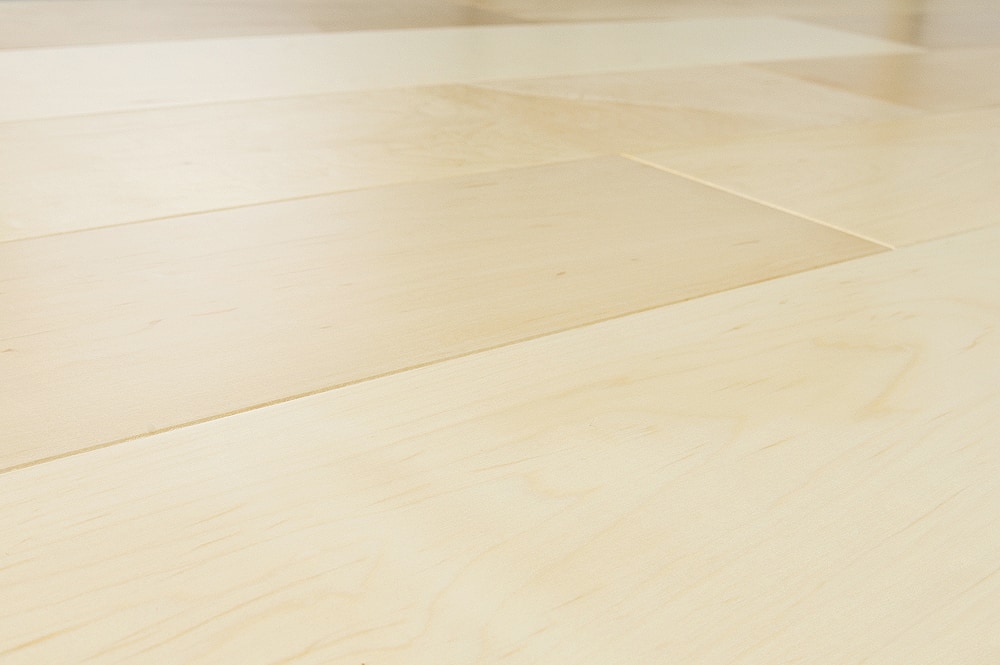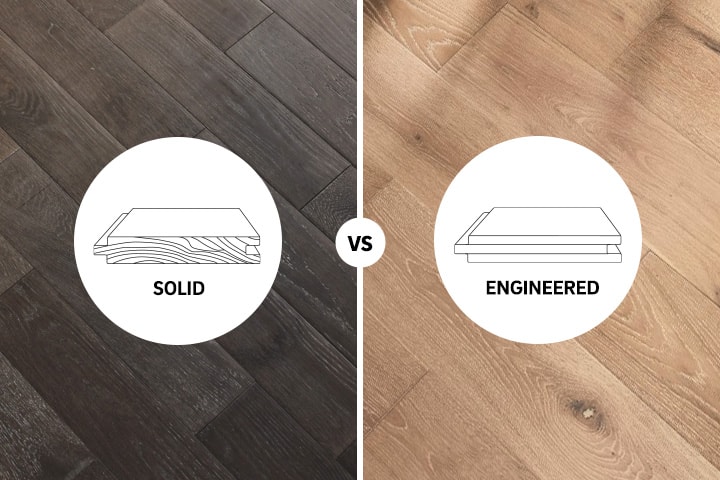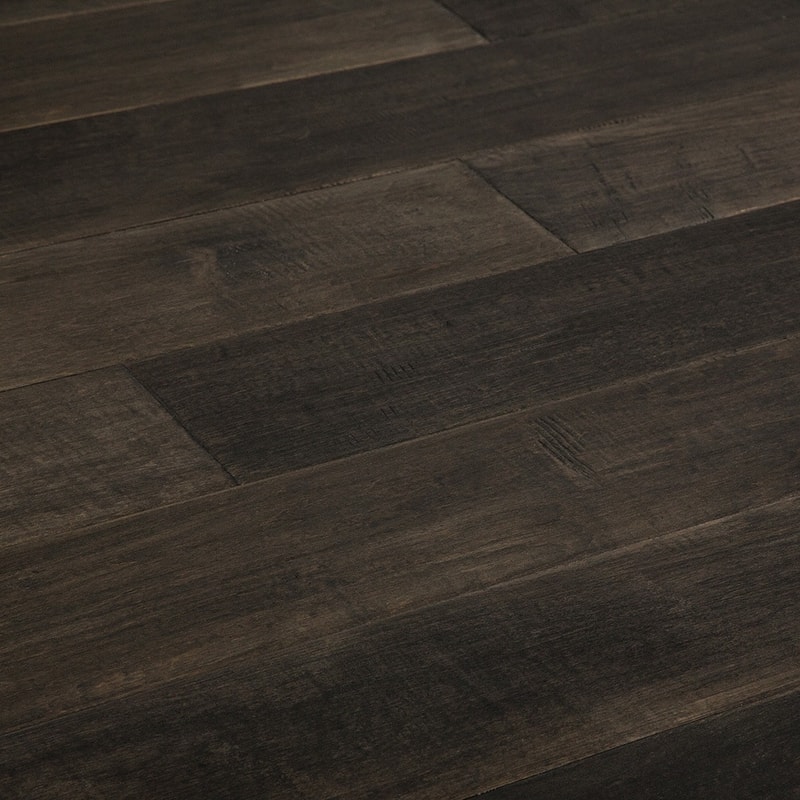Maple is an impressive type of hardwood flooring that provides a durable, elegant look that can make your home stand out. We’ll cover a lot of different aspects in this article to better understand why it is loved by so many.
In this article, we’ll even cover the laminate and engineered options available to you too.

Is Maple a Hardwood: Hard Maple vs Soft Maple
First of all, we want to take a look at a commonly asked question: Is maple actually a hardwood or not? And why do people talk about hard maple vs soft maple? What is the difference that you need to know about?
These trees is one of the common species in hardwood forests in the country, although the many different variations is probably what is causing the confusion with regard to how to classify this type of wood, and why it is commonly spoken off as two types of actual lumber.
Types of Maple Trees
- Soft Maple – The Soft Maple includes variants such as the Bigleaf Maple (Acer macrophyllum), Box Elder (Acer negundo), Red Maple (Acer rubrum), Silver Maple (Acer saccharinum) and Striped Maple (Acer pensylvanicum). “Soft Maple” is a term used to describe tehse different species.
- Hard Maple – Hard Maple refers to Acer saccharum, also known as Sugar Maple. Hard maple is 25% harder than Soft Maple, hence where it got its name from also, and that is why it is commonly used for floor installations also. Soft Maple is often used for kitchen cabinets on the other hand, as well as other things such as furniture.
How to Tell Them Apart
Whether it’s one type or another can sometimes be hard to tell, and it might just require a pro to be able to tell you, although there are different things that you can look for to determine which type it is you’re dealing with.
If you can make a dent in the wood, it’s likely the softer kind, although not everyone has the force to leave a dent in the softer wood either. The density of the wood is a better way to determine if you’re dealing with one type of wood versus another, although that will require you both having the cubic footage and be able to weigh it. For reference, a cubic foot of Hard Maple will weigh 44 pounds on average.
There are subtle differences between the different subspecies and the endgrain may give you an indication also of which wood you’re dealing with. Hard Maple is usually lighter in color and its color is more uniform too. Alternatively, softer types are darker and can be red, brown or gray. The growth rings in harder wood will also be closer together, in general.
Buying It – What Are Your Options?
There are different options that you can choose from when it comes to maple hardwood flooring.
- Maple Laminate Flooring – are you very cost-conscious? If so, this could be a better option for you to choose. While laminate flooring is not in fact made from maple, if you still want the look, this can be a better option for you to go with. There are a lot of different color and style options with this.
- Engineered Maple Flooring – the manufacturer will determine the style, widths and lengths that this type is available in.
- Solid Maple Wood Flooring – the lengths and widths depend on the manufacturer. The thickness is usually 3/4″ but can vary too. You can get them either unfinished or pre-finished depending on your liking. Pre-finished ones will either have been stained or sealed to provide the desired color, and this solid wood option is actually the most authentic option if you will.
Let’s take a deeper dive into the comparison between the solid option vs the engineered option and why you might consider choosing one over the other, in order to make sure you make the best choice.
Solid Maple Hardwood vs. Engineered Maple Wood and What is the Difference?
If you don’t commonly shop around for wood, you may not even be aware of what exactly the difference is between the two, which is why we want to help you figure it out.

Photo Credit: armstrongflooring.com
The photo above shows the difference very well between the two materials to help you understand the composition of each. Both of the option will come available in a range of different styles, but the different way they’re built will give each type certain pros and cons. Solid wood may seem more authentic because it is nothing but the wood it’s supposed to be. It’s simply a solid piece of wood that is installed.
Contrary, engineered maple is made up of different layers and it is typically only the top and bottom layer that actually consists of maple, while the other layers are typically made of plywood. The core of the planks can consist of as many as 7 layers of plywood.
Maple Hardwood Flooring Pros and Cons
The pros and cons for the actual solid maple hardwood floors too, and how it compares to other types of wood also.
Pros
- It is easy maintain and clean when it has been finished – the finish will add a protective layer on top of the wood which also in turn makes it easy to clean.
- Hard wood that doesn’t easily dent – because if it’s density and how hard it is, it’s not likely to dent.
- Ideal for a contemporary, clean look – if you are going for the Scandinavian, minimalist style this type of flooring will match perfectly with the rest of the house given how light it is
- Uniform look that offers a range of opportunities – it can easily be paired with a lot of design options. Even if you choose to change furniture, it will still be a beautiful option to have installed.
- Competitively priced – different grades offer different opportunities depending on the amount of money you’re willing to spend on the project.
- Locally sourced – given that it is locally sourced in a lot of different places in the country, it is a more environmentally-friendly choice than other types of hardwood.
Cons
- Wood is susceptible to moisture damage and can swell as as a consequence – changing temperatures and humidity levels will cause this type of wood to expand and contract the same way that other types of wood would, which can eventually cause squeaky floors. Warping and cracking can happen as a consequence and the material should not be installed if it is expected to be exposed to high levels of humidity. A dehumidifier may solve problems with humidity.
- Other types of wood may be more appealing to people desiring more advanced looks. Maple’s uniform look works in a lot of cases but more intricate types may be preferred in some cases.
- It needs to be finished with water-based Polyurethane – using oil-based Polyurethane can give the wood an undesirable yellow finish over time.
- Staining maple needs to be done by a professional – pre-stained planks are readily available but alternatively, it’s a job for hardwood floor refinishing contractors to ensure it’s done properly.
- Sealant must be applied to minimize the impact of scratches – area rugs can also provide great protection against scratches although they will obviously cover the floor.
Colors Available for Staining

While it is possible to stain it, this should be done professionally since it may otherwise make it difficult to hide imperfections made during the sanding. It can be stained in practically any color you desire.
Engineered Flooring Pros and Cons
Engineered maple has a lot of different pros and cons you may be interested in learning more about.
Pros
- Good moisture resistance – because of it’s composition, this option is more likely to be used in places with a lot of moisture, such as basements and bathrooms. A moisture meter is still recommended since they do still contain natural wood and extreme conditions will cause them to warp.
- It’s better when installing on top of both concrete slab and radiant heating systems – while it does install better over these types of surfaces, you should still make sure that the subfloor has been waterproofed before the installation happens. The great thing about being able to install on top of these surfaces is that you can create a consistent look throughout the home where solid wood would be very impractical to install.
- It’s very low maintenance too
- No dust is created in the cutting process – as a result you will get a higher percent of the maple actually being used.
- Replenishing the trees is a lot easier with engineered wood – Hard Maple grows slowly and since you can use faster growing woods for the engineered core, the amount of slow-growing wood will be lower with this process.
- Engineered wood is often less expensive to buy.
Cons
Engineered maple also has cons that are worth mentioning.
- They can’t be re-sanded and refinished as many times as solid wood – since the top layer is thin, they won’t be able to be refinished as many times as solid wood, which effectively may mean they only last half as long. The thickness of the top layer will determine whether they can be refinished or not.
- Some manufacturers use low quality core layers – since they say it’s just going to be in the middle, some manufacturers may not use the quality materials that are still required, and an alternative material that is sometimes used is oriented strand board, also known as OSB.
- Less eco-friendly – while it may be easier to replenish the wood source, there are a lot of bi-products and additional things that go into engineered wood such as glue.
Laminate Pros and Cons
Although not technically an actual wood, we’ll briefly walk you through the pros and cons of maple laminate flooring.
Pros
- The installation is easy for a pro – installing this type of flooring is easier than solid wood.
- Little required maintenance – sweeping the floor is, however, important in order to keep abrasive things from damaging the top layer.
- You’re not depleting a slow-growing type of tree.
- Lightweight
Cons
- This option is not good for areas with a lot of moisture – if there’s a sump pump in the room, you probably shouldn’t be installing it in that room.
- No possibility to refinish it – what that means is that it will need to be replaced when it’s worn out, and that the quality of the product is especially important.
- It’s not the same as actual maple and won’t increase the value of your home the same way either.
- Laminate pollutes landfills – it doesn’t degrade there because of the way it was made, making it a less eco-friendly option.
Does it End Up Turning Yellow Over Time?
The answer to that question depends on several factors. Woods with light tones will often turn amber as it ages because of the natural oils contained within the wood, which is unfortunately difficult to avoid. In order to avoid it excessively turning yellow, you should be sure to only use water-based Polyurethane, which helps bring out the richness of the wood without additionally turning it amber.
Direct sunlight will also increase the rate at which it starts turning yellow, and tinted glass or blinds can help protect it against these forces. Adding these can also help you save money on your energy bill since your HVAC unit won’t be working as hard to keep the temperature comfortable in the house.
What Colors, Stains and Textures is It Available in?
Most homeowners simply choose to use a clear sealant finish on top of their maple floors to bring out its natural, beautiful look.
Staining it should be left to the pros, although it is sufficiently porous to be able to be stained, should you desire to change either its color or texture. Should you desire to have it in a different color, buying a pre-stained option is often considered the easier choice and saves you from trying to do the work yourself. Unique color blends can be arranged with the help of a contractor. The pre-stained colors include white, tan, red-brown, orange, multi-color, gray, dark-brown, copper, brown, black and beige.
The textures available for maple flooring include hands scraped, smooth and wire-brushed depending on your preferences.
Hardness Rating
The hardness rating of maple flooring is 1450 on the Janka scale. The equivalent number for oak flooring is quite a bit lower, and it means that it won’t dent as easily. When it is protected with Polyurethane, this finish may scratch, although it will not affect the underlying wood. When the floor is finished the following time, the scratches will once again be gone.
The color of the grain can make scratches more visible than darker types of wood would. High-traffic areas will benefit from area rugs to keep the floor protected, and it should be refinished with water-based Polyurethane to protect the surface.
Different Grades
Different grades of maple flooring are available from different manufacturers and the grade will be an indication of the quality of the wood that you’re buying. The most expensive grade is grade 1, which is also the mots uniform in color. It has only few, if any, visible knots. Grade 2 has more knots and will have more color variations too. Grade 3 provides a more rustic appeal and is also the most economical choice among the three. Either grade will still provide you with an attractive-looking floor.
Hand-Scraped
The hand-scraped texture that maple flooring is available in is a lot more rustic texture, made to resemble the use of hand-held tools. These imperfections create a more old-looking plank, although it can still be finished as modern floors. The amount of hand-scraping will also vary between manufacturers, and this look will have the benefit of hiding small imperfections and scrapes. You will no longer need to worry about a dent created by a something that was dropped onto it.

As you can see, the surface of the material isn’t smooth.
Reclaimed and Salvaged Flooring
Because of its strength, maple flooring is available as a reclaimed and salvaged material taken from industrial applications. Using reclaimed wood is also a very environmentally-friendly decision that helps avoid excessively cutting down additional trees.
Maple Hardwood Flooring Cost
Maple hardwood flooring is a beautiful option to go with that will cost you as little as $2.59 per square foot when you go for an unfinished option. Pre-finished options start at $2.79 per square foot. The most expensive option will cost as much as $8.61 per square foot for Armstrong Prime Harvest Maple Collection. Popular brands include Somerset, Mohawk, Armstrong and Bruce.
Maple vs Oak
Maple and oak are both popular hardwood options among homeowners, and we have previously been asked how they compare, hence this comparison. We already mentioned the fact that maple is harder than oak, but what else sets them apart?
Pros and Cons of Oak
oak is more successful at creating a dramatic, dark ambiance, while maple is lighter and more popular for contemporary looks. Oak is a very traditional material that has been used for a very long time. Oak starts at $1.49 per square foot for builders grade, making it a cheaper material if you simply want a budget-friendly option. That is even when it has been finished, with a 20-year limited warranty.
Maple vs Hickory
Hickory is a type of hardwood with a more varied, distinct look, making it appealing to some homeowners. While maple has a very uniform look, that is not always the case with hickory. It often comes available in very wide planks that really show off the grain and all of its beauty. Hickory is more durable than maple with a Janka score of 1820.
Birch vs Maple
Birch is a warmer type of wood than maple and is also slightly softer, which does tend to expand and contract quite a bit. Some users on the internet seem to prefer maple over birch as a flooring option. The cost of birch flooring can sometimes be lower than that of maple.
The color variation is also greater than what you would expect from maple. It has an interesting visual appeal as a consequence.
Types of Birch
There are also different types of bitch to choose from, although it’s still a chosen few that seem to rule the market. The most common ones you will be able to find include:
- Sweet birch – this is the hardest of the different types, comparable to oak and sugar maple.
- Yellow birch – in terms of hardness, it’s more or less the same as green ash.
- Paper birch – it scores roughly 910 on the Janka scale, compared to 1450 for sugar maple, making it softer than red maple.
The lowest grades of birch start at about $2 per square foot.